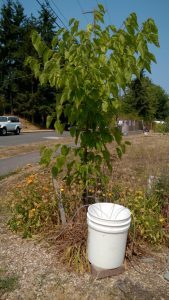Working With Weather When Watering
August 28, 2017
It’s dry this summer. It seems like we are either watering, or obsessing about whether we are  watering too much or too little.
watering too much or too little.
Nobody wants to over water fruit trees. Why waste water. Excess water creates more tree growth, not more fruit, and results in nutrient leaching.
Ideally, we are watering just the right amount to maintain a healthy disease resistant tree but also good fruit production.
Cliff Mass’s August 24 blog says July and August 2017 combined will be the driest in 100 years. That sounds dramatic. However, data for 2017, in relation to 2016, shows only slightly higher temperatures and only 1.12 less rain over the period June, July and August. Why is 1.12 less rain making such a big difference?
Let’s say you were comfortable with your 2016 watering, meaning the trees are healthy and the fruit set was reasonable this year. You are watering about the same this year but now you want to make up for the fact that we have had less rain in 2017.
Obviously, 1.12 inches of rain is more beneficial than just adding 1.12 inches of water to a tree guild but we will add an additional 1.12 inches just to the root zone of an apple tree. The tree’s root zone is where most of the water absorbing roots are located. This root zone is not located close to the trunk of an established tree; it is at the tree’s “drip line” and beyond. WSU’s Dr. Troy Peters points out that this active root zone is usually two to three times the diameter of the tree’s crown or “umbrella.”
If we estimate the active root zone of our tree to be 100 square feet and we want to add that extra inch of water, then we need 8.33 cubic feet of water or 62 extra gallons!
If we apply the deficit irrigation concept, we might add less and, if we used something other than drip irrigation, which is 90-95% efficient, we would add more. (Sprinkler systems are only 80% efficient and furrow systems only 70% efficient.)
How do the Pros Efficiently Use Water?
To improve water efficiency, you have to know how much water you use and we do because we water with 5-gallon buckets.
Pros take into account the amount of water lost from the trees pulling up water through their roots and pushing it out the stomata of their leaves (transpiration) and also how much water evaporates from the soil into the air (evaporation). The combined effect is evapotranspiration (ET).
ET models are largely based on temperature and are based on water use of alfalfa (Eta) or on grass (ETo). Each crop uses a certain percentage of the water that alfalfa uses and that is the crop coefficient (Kc). An apple orchard with active ground cover has a .8 Kc at initial stage of fruit development, then 1.2 mid season and .85 at end of season, prior to leaf drop.
There are many variables to consider other than temperature and crop coefficient, like wind, leaf growth, humidity, day length, soil type, and intervals between watering. However, for ease, if we think of the apple crop coefficient at 1.0, then we can use ET as a guideline for irrigation.
If you log into WSU Weather AG and click on Irrigation, Irrigation Scheduler, you can enter your location, a crop and your soil type and it will tell you how much water the apples are using (ET), how much precipitation we have had and, most importantly, it will show you the water deficit, including the cumulative deficit. The cumulative deficit as of August 27, beginning from May 21, is 5.3 inches. That number will be in red. You don’t have to add 5.3 inches unless you have not watered at all this summer!
Dr Peters writes that orchardists tend to over water in the spring and fall and underwater in July. He also summarized the signs of under watering during the hotter part of the summer:
1) smaller than average fruit size
2) poor fruit shape
3) bitter pit in apple, or increased cork spot and “hard-end” in pears.
4) stored fruit loses pressure more rapidly
Stay tuned as we consider writing for a grant to apply more water conservation strategies at the orchard.
Ruth

Thank you!
Recently our Spitzenberg apple tree was very severely pruned.
i don’t think the nephew knew what he was doing. Any advice
will be appreciated.
Hello Greg
This is the correct time for summer pruning. However, most arborists don’t like to take out any more than 30% of the canopy during one season. Also, if you are worried that the apples might get sun scald because there is now so little canopy, remember that the intensity of the sun right now is about what it is in April.
It all depends on the size and age of tree but extra water would be in order.
Ruth